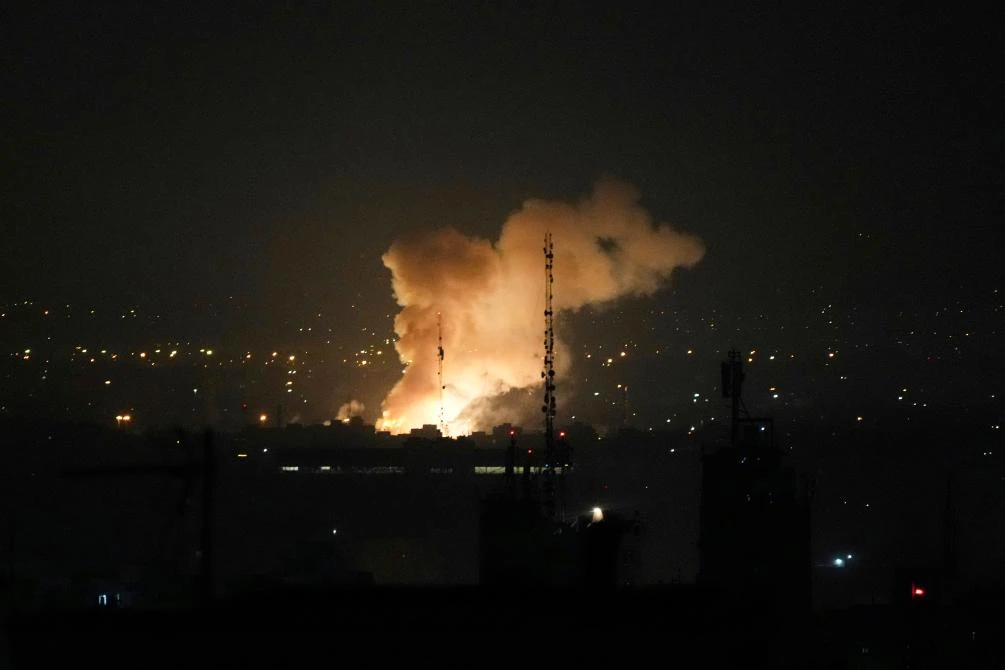Original | Odaily Planet Daily ( @OdailyChina )
Author | Ethan ( @ethanzhang_web3 )

This morning, American missiles disrupted the fragile balance of the crypto market.
According to CNN and other media reports, US President Trump ordered strikes on Irans three nuclear facilities, Fordow, Natanz and Isfahan, with Fordow experiencing a full bomb drop. Although Iran claimed that it had already completed the evacuation in advance, the market is clearly unable to withstand this round of sudden risks from the Middle East.
OKX market data shows that as of press time, BTC fell to a low of $100,866, and briefly rebounded to $102,256, a 24-hour drop of 1.22%, approaching the psychological barrier of $100,000; ETH fell to a low of $2,215, temporarily reported at $2,263, a 24-hour drop of nearly 6.67%; SOL, DOGE, PEPE and other altcoins fell simultaneously, with declines ranging from 4% to 8%.
In the derivatives market, according to Coinglass data, the total network liquidation in the past 24 hours was as high as 675 million US dollars, of which long positions were liquidated for 595 million US dollars, and the ETH liquidation amount reached 275 million US dollars, which was the largest liquidation in the current period, and BTC liquidation was also as high as 151 million US dollars.

Alternative.me The Fear and Greed Index showed a decline from 49 (good) yesterday to 42 (fear), and the mood was slightly depressed.
The battle between long and short is imminent
But at the same time, big funds did not withdraw, but quietly buy low. According to the monitoring of on-chain analyst Yu Jin , a whale/institution that had previously accurately long ETH bought 13,498 ETH again this morning, with a total value of over 30 million US dollars. Since June 11, it has bought more than 130,000 ETH in total, with an average position cost of 2,540 US dollars, and currently has a floating loss of nearly 40 million US dollars.
Short sellers are also gathering in force. Monitoring accounts show that a certain whale has made a total floating profit of more than $20.65 million from its 58 short positions in cryptocurrencies since June 16, with ETH making the best profit at $4.2 million.
In the fierce battle between bulls and bears, Bitcoin and Ethereum are at the center of the storm.
Market outlook: Geopolitical storm + macro disturbance, where will the price be anchored?
This sudden geopolitical storm has made the market realize once again that Bitcoin is not a safe haven gold but a volatility amplifier. However, has this round of decline become a release of extreme emotions caused by the Middle East geopolitical crisis? The next market focus will turn to the superposition of the Feds policy path and the direction of the regional situation.
After the United States assisted Israel in attacking Irans nuclear facilities, BTC once fell to nearly $100,000, and mainstream and altcoins such as ETH began to plummet simultaneously. Although Iranian officials said that the three major nuclear facilities have been evacuated in advance and the United States also stated that there is no further attack plan for the time being, the situation in the Middle East is far from settled, and the market is still pricing in risks rather than outcomes.
At the same time, changes are also quietly taking place at the macro level: although the Federal Reserve started a rate cut cycle in September 2024, and the federal funds rate has been cut by 100 basis points after three rate cuts, a number of officials, including Powell, have recently released hawkish signals, saying that interest rates are close to a neutral level, and the pace of rate cuts may slow down in the future. The markets expectations for another rate cut in 2025 have been lowered from four times to two to three times; and long-term U.S. Treasury yields have rebounded, the U.S. dollar index has re-strengthened, and the global financial environment has shown a de-risking trend. As a risky asset, the crypto market naturally became the first round of clearing targets.
Valentin Fournier, chief analyst at BRN, noted that inflation has cooled and tariff concerns have eased, but slowing U.S. economic growth has raised concerns about stagflation. Fed Chairman Jerome Powell expressed confidence in the deflationary trend in a slightly dovish tone at a press conference after the meeting, but he pointed out that solid job growth and strong consumer spending provide policymakers with room to maintain high interest rates. With no urgency to cut rates, the Fed reiterated its wait-and-see approach, delaying expectations for the first rate cut until September. Because Bitcoin is a decentralized, borderless digital asset, it is uniquely positioned to absorb these capital inflows regardless of the Feds domestic policy stance.
However, there are also views that Ethereums on-chain fund movements show that the market is reconstructing the mainstream asset consensus. With the continued increase in whale holdings, traditional companies incorporating ETH reserves, the SEC loosening DeFi supervision, and active call options, ETH may be becoming a value anchor in risk aversion.
The subsequent BTC price trend will largely depend on the game of the following three variables:
Will geopolitics escalate further? If Iran strikes back strongly and the United States or Israel strikes back, it will push the market further into risk aversion mode, with gold strong and cryptocurrencies under pressure. On the contrary, if the situation remains in a state of conflict without breaking the game, sentiment may gradually recover.
Will the Feds liquidity attitude change? If the Fed releases more dovish signals at the July or September FOMC meeting, the crypto market will get a policy respite and funds will flow back. Otherwise, there is still more risk of a pullback.
Has BTC technically fallen below the bull market structure? Currently, BTC is still in the strong support zone of $100,000 to $105,000. If it loses $96,000 to $98,000, it will trigger a larger level of technical correction; if it rebounds and stabilizes, it may build a new round of accumulation platform.
From a game theory perspective, the current situation is more like a double wash of liquidity + sentiment rather than the end of the bull market. As FalconX said: The correlation between Bitcoin and traditional risk assets is weakening, and future prices will be more dominated by on-chain structure, institutional layout and policy games.
Conclusion: Chaos is the breeding ground for order
The crypto market is entering a new cycle full of variables.
The macro storm has not yet subsided, the geopolitical crisis has suddenly struck, and the high-level operation of risky assets has made market sentiment highly sensitive. Every tweet, every round of negotiations, and every airstrike are sparks that ignite volatility. But behind the sharp drop, we see that bulls are adding positions and bears are arbitrage. ETH is being bought repeatedly by whales. The data on the chain never lies - the market is playing a game, not escaping.
Next, can Bitcoin hold the psychological barrier of $100,000, will ETH become the safe haven of this round, and will altcoins continue to be marginalized? Perhaps it will take time to verify before we can see a clearer answer.










